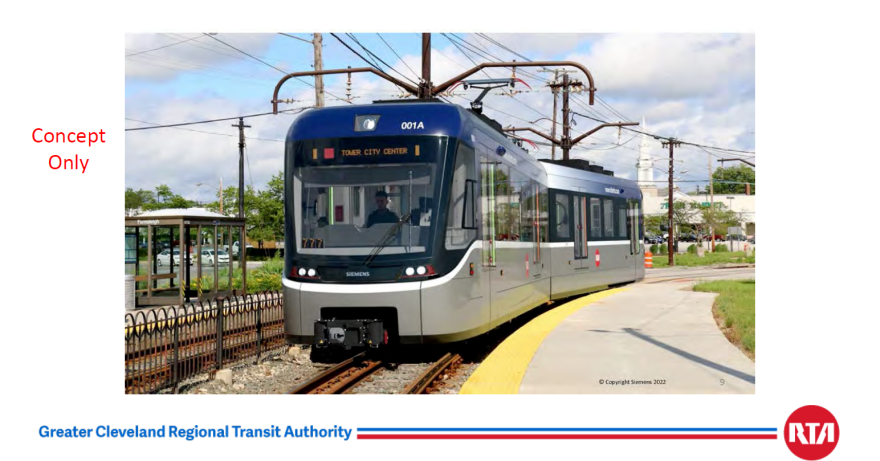The Greater Cleveland Regional Transit Authority (GCRTA) board approved its Rail Car Replacement Project Tuesday which will replace the transit agency’s 69 current rail cars with as many as 60 high floor light rail cars over a seven-year period.
The updated rail cars will be ADA accessible, and come with 52 plastic passenger seats as opposed to 72 fabric seats per car in the current fleet.
Roshell Wiley uses the GCRTA's rail service to get to work. Though there is usually enough seating during her regular commute, busy game days typically mean a packed train.
“On game days they need to just have [trains] going, like of them or something,” she said, “because there's people coming in from off of work and the train be so packed, so packed, and you have nowhere to sit down.”
Fewer seats on the new rail cars might mean longer wait times between trains, she said, adding time to the daily commute.
“Less seats are definitely going to be worse, but then again, though, everybody can't get on,” she said. “So, they will have to have another train coming back for the other people, because there's going to be a lot of people they would like to get on.”
The new rail cars will also have two wheelchair-accessible seats and four bicycles capacity per rail car.
15-year-old Daniel Chacon rides every day with his bike to get to and from school. Since the current rail cars don’t have a designated area for bikes, he typically places his bike in the ADA-accessible space reserved for wheelchair users.
“If there's a handicapped person using that, I'll just set it in an area where it doesn't take up too much space and stand there with it so it doesn't fall over,” he said.
Chacon is happy to know he’ll be able to store his bike on designated bike racks on the new rail cars to avoid potentially inconveniencing other riders.
“The bike rack sounds like it's a really great idea because I need to put my bike somewhere and I don't want to take up the handicapped spots,” he said. “I don't want to waste anybody's time if they need to get there and having to move and all that.”
Jonathan Steirer typically relies on public transit and his bike to get around Cleveland, but he said he avoids bringing his bike for the same reason.
“The bikes tend to just roll around and fall over as the train moves, so you have to be right there,” he said. “I've seen people lock it to the train to help it kind of brace itself, but it's just a little annoying.”
The replacement project would allow GCRTA to increase rail route flexibility, and create trips for passengers the current infrastructure cannot, Chief Operating Officer Floun’say Caver said at a committee meeting earlier this month.
“These rail cars provide us with opportunities for new service alignments that will completely enhance our customers’ riding experience,” Caver said in the news release. “Imagine the ability to take a train directly from the Green Road Station to Cleveland Hopkins International Airport Station without having to switch trains at Tower City.”
When it comes to expanding service, Eric Schnadig said a good place for GCRTA to start is with the riders.
“I would ask, what do the citizens of Cleveland want?” he said. “I'm assuming that informs what the city's doing, but that's always a good place to start. Ask your customers.”
Schnadig visited Cleveland from Boston. Though he’d only ridden Rapid Transit twice, to get to and from Cleveland Hopkins International Airport to Downtown Cleveland, he said his experience was a nice one.
“The Rapid is right at the airport and then it takes ten stops and you're right in the heart of downtown,” he said. “We don't have that in Boston. You have to take a bus to the train or the bus to downtown. So, I think that's a positive impression.”

Rider Jonathan Steirer said he’s happy to see GCRTA already thinking about expanding rail routes through this project, but he hopes the transit agency will consider the needs of those who rely solely on public transportation in addition to those who use the service for work commutes.
“I would love to see a continued eye towards all day frequency and service reliability, and how does it integrate with busses and how does that integrate with changing job and population centers,” he said. “How does that kind of result in ridership increases, or how could that benefit ridership?”
Laurie Prince used Rapid Transit for her daily commute to work before she began working remotely. She said she would encourage others use the service, especially if GCRTA implements a rail expansion.
“Just the convenience of not having to drive and park and pay all that extra money for all of those things,” she said. “It's cheap for that. [It] makes it easy.”
@GCRTA Board of Trustees approved rail car builder @SiemensMobility during the April 18, 2023, Board Meeting. Many thanks to our Board, Executive Staff, RCRP Team, and all staff involved in this collaborative, transformative project. Read more at https://t.co/cxKqBBUmkX pic.twitter.com/CQVqfeWnJF
— Greater Cleveland RTA (@GCRTA) April 18, 2023
Current rail cars range from 39 to 42 years old, and though they are still safe to operate, Caver, GCRTA's Chief Operating Officer said during the committee meeting, but due to their age, the cars are prone to rust and corrosion. An evaluation of the rail fleet found that it would be more effective for GCRTA to replace the fleet, rather than repair the rail cars individually.
“The rationale for that replacement was that our trains were experiencing structural loss from corrosion, that there was a lack of readily available parts, and that the cost of rehabilitation of the fleet would far exceed the replacement cost,” Caver said.
GCRTA selected Siemens Mobility Incorporated as the vendor for the project.
“I'm very grateful to the RTA for their confidence in us,” Siemens President of Rolling Stock in North America Michael Cahill said. “We look forward to engaging the community and engaging the organization when we sit down to design and build these cars.”
The replacement is expected to cost $393 million, which includes the cost of the cars, infrastructure and railroad changes, and spare parts. The board is expected to vote on the project at its April 18 board meeting.



